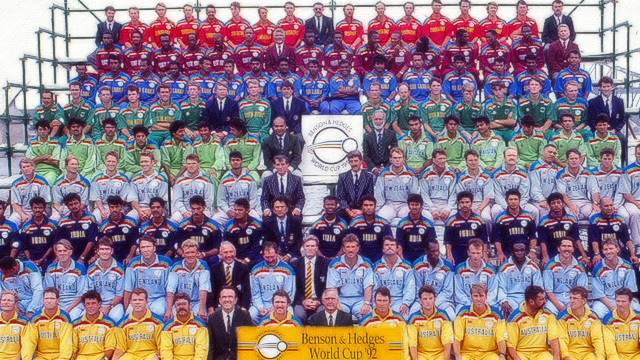1992-2019: The evolution of Team India’s World Cup Jersey

It has been three decades since the Kapil Dev-led Indian team lifted their first World Cup trophy and nine years since MS Dhoni & co. repeated the feat. These historic moments of India’s cricketing history are still fresh in every Indian cricket fan’s mind.
Back in 1983, ODI cricket was played in 60 overs instead of the 50-over format and all teams donned plain white Test jerseys. It was with the introduction of the Kerry Packer World Series Cricket in the latter part of the year that coloured jerseys saw the light of the day.
The day-night ODI was played between WSC West Indies and WSC Australia, with WI sporting pink and the Aussies wearing golden jerseys. It was held at the Sydney Cricket Ground where white cricket balls and a black sightscreen was first introduced.
The first three editions of the World Cup were all played in whites. The 1992 World Cup was the first time coloured jerseys made their way to the tournament. This was the same year that South Africa returned to international cricket after the apartheid era.
Over the years, the Indian cricket team’s jersey has evolved drastically, sporting various shades of blue and other colours including those from the national flag.
1992

Image Courtesy: Scroll.in (spotted – Team India in the 3rd row from the bottom)
Co-hosted by New Zealand and Australia, the 1992 World Cup was the first edition where all 9 participating teams including South Africa featured in their respective coloured jerseys. The Indian team was spotted wearing dark blue colours instead of their regular light blue ODI kits. The shoulders had blue, green, red and white coloured stripes. The word ‘India’ featured right in the middle of this iconic jersey in light yellow colour.
1996

Image Courtesy: Twitter
The World Cup was played in the subcontinent for the first time in 1996 with India, Sri Lanka and Pakistan as hosts. This particular edition was in the limelight from start to finish for more reasons than one. First, Australia and West Indies refused to play their matches in Sri Lanka owing to security concerns. On the other hand, disappointed fans at the Eden Gardens burnt down the stadium chairs after they saw India losing to the Lankans in the semi-final.
For this World Cup, the Indian team was seen wearing light blue jerseys with yellow stripes across the chest and a yellow collar.
1999

This edition was hosted by England and featured 12 participating teams from around the world. Six teams were divided into groups of 2 as per the Super Sixes format. India stood second in their group, but their performance in the Sixes stage was poor.
India’s jersey in this World Cup was similar to that of 1996, with the addition of black borders to yellow collars. It also featured the logo of the Board of Control for Cricket in India (BCCI) in a unique design.
2003

Image Courtesy: Sportskeeda
This World Cup hosted by South Africa was one of India’s most successful campaigns. Once again, 14 teams were divided into groups of two. India performed exceedingly well throughout the tournament and made it to the finals to face Australia. But the Aussies continued their domination from 1999, winning their second title on the trot.
The Indian jersey witnessed a noticeable transformation in this World Cup with the blues deepening and yellows disappearing. Across the chest was the word ‘India’ with tricolour stripes in the background.
2007

Image Courtesy: Sportskeeda
The 2007 edition held in the West Indies has been the worst World Cup for India by far. India were jolted by an unexpected loss from Bangladesh in the group stage. This loss came as a shock to many who touted India to be favourites that year, especially after being finalists in the previous edition. Although they finished 3rd in their group, they could not qualify for the Super 8.
The light shades of blue made a return to the Indian jersey this year. This was arguably India’s tidiest jersey yet, with ‘India’ written in bold yellow colour. The tricolours made their way to the side of the shoulders.
2011

28 years after first lifting the World Cup trophy, Team India clinched their second title at the Wankhede stadium in Mumbai. This win was special in more ways than one. It was Sachin Tendulkar’s first World Cup victory after having spent 24 years in the national setup. The victory was made even sweeter because it came on his home ground in Mumbai. This was a special World Cup for Yuvraj Singh, who led the team to victory all the way despite fighting for his life during the tournament. This final is also remembered for MS Dhoni’s match-winning six that sealed the deal for India against Sri Lanka.
The team jersey remained more or less the same, with slight alterations in the colour and placement. The most noticeable change was the saffron coloured ‘India’ written across the chest.
2015

Image Courtesy: India.com
The 2015 edition of the World Cup moved down under, with Australia and New Zealand once again acting as co-hosts. Coincidentally, both these teams faced off in the all-important finale. Australia won the game and became five-time world champions.
India performed well consistently and remained unbeaten throughout the group stage. They even went past Bangladesh in the quarter-final. However, Australia put the brakes on India in the semi-final with a 95-run win.
In their bid to save the environment, sports brand Nike designed Team India’s jersey for this World Cup using 33 recycled plastic bottles. Similar to the 2011 design, the only additional was that of white borders.
2019

Image Courtesy: BCCI
The 2019 World Cup was played in England and Wales with 10 participating teams, where the round-robin format made a comeback after 27 years. The top 4 teams to qualify for the semi-final stage were India, New Zealand, England and Australia. Having performed consistently throughout, India were ousted by the Kiwis in the semis, in what was a 2-day affair thanks to the rain.
This year’s jersey was probably the smartest-looking, with dark blue shade occupying most part of the t-shirt and the pants. The word ‘India’ continues to make an appearance across the chest.
